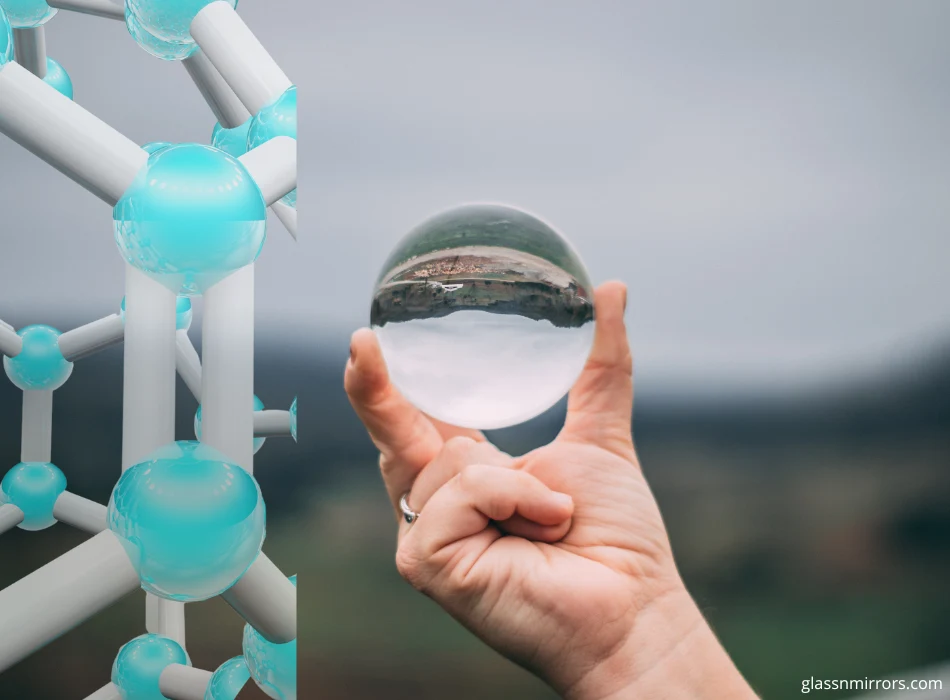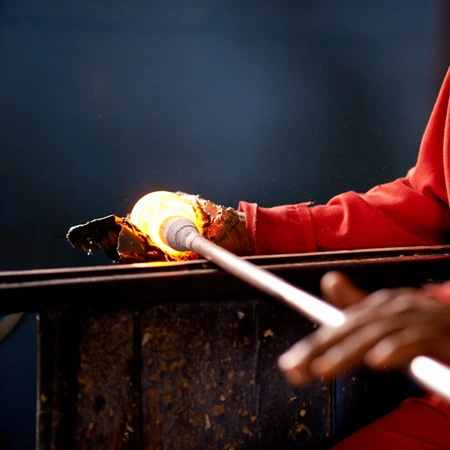You may have heard the term “polar” used when discussing glass. But what does that mean? And why is glass polar in the first place?
The difference between the electronegativity of the atoms that make up glass creates polar molecules. The Oxygen in glass (SiO2) has a higher electronegativity than the Silicon. This creates a situation where the Oxygen atoms have a greater pull on the shared electrons between it and the Silicon, causing a small dipole moment.
In this blog post, I will explain what polarity is and why it matters for glass. Let’s get started.

Table of Contents
- 1 Why Is Glass Polar?
- 2 Can Glass Be Non-Polar?
- 3 What Is Glass Polarity?
- 4 Are Polar Substances Attracted To Glass?
- 5 What Causes A Polar Bond?
- 6 Is Glass A Polar?
- 7 What Factors Affect the Polarity of Glass?
- 8 How Does Polarity Affect Glass?
- 9 How Is Glass Made?
- 10 Final Thoughts – Why Is Glass Polar?
- 11 Hot Glass vs Cold Glass – What’s The Difference?
- 12 Can Quartz Be Made Into Glass? Guide On Quartz & Glass
Why Is Glass Polar?
Glass is polar due to the difference in the electronegativity between oxygen and silicon. Oxygen is more electronegative than silicon, with an electronegativity value of 3.44. Silicon has an electronegativity value of 1.19. This difference in electronegativity between oxygen and silicon creates a dipole moment in the glass.
With Oxygen being more electronegative, it will pull the electron clouds closer to itself. This will leave the Silicon atom with a slight positive charge. The opposite happens on the other side of the glass molecule, with Silicon’s Electronegativity being lower; it will cause that end of the molecule to have a negative charge.
This creates a dipole moment, where one side of the glass molecule is slightly positive and the other side is slightly negative.
Polarity in glass affects many of its properties, including its ability to dissolve in water. Glass is insoluble in water because water molecules are also polar. The negative end of the water molecule is attracted to the positive end of the glass molecule, and the positive end of the water molecule is attracted to the negative end of the glass molecule.
The attraction between the glass and water molecules is strong enough to overcome the attraction between the water molecules themselves. This is why glass does not dissolve in water.
Can Glass Be Non-Polar?
Since glass is made of SiO2, it would be impossible for glass to not be non-polar. Even if there were no dipole moment, the oxygen and silicon atoms would still have a difference in electronegativity which would make the molecule polar.
You would need to change the structure of the glass completely in order for it to not be polar. For example, you could make a carbon-based “glass” that would not be polar because carbon and oxygen have the same electronegativity. But that wouldn’t really be glass, would it?
What Is Glass Polarity?
To understand glass polarity, we first need to understand what polarity is. Polarity, in Chemistry, refers to the separation of electric charge leading to the formation of a molecule or its constituents having an overall electric dipole moment.
In order for a molecule to be polar, there must be a difference in the electronegativity of the atoms that make up the molecule. The higher the electronegativity difference, the more polar the molecule will be.
Glass is made up of SiO₂ molecules, which have a difference in electronegativity between the silicon and oxygen atoms. This creates a dipole moment, where the oxygen end of the molecule is slightly negative and the silicon end is slightly positive.
More specifically, Oxygen has an electronegativity of 3.44 while Silicon has an electronegativity of only 1.19. This difference in electronegativity creates a dipole moment, which is what gives the glass its polarity.
As I explained earlier, glass polarity affects many of its properties, including its ability to dissolve in water. Water molecules are also polar, with the oxygen end being negative and the hydrogen ends being positive.
Polarity also affects the way light travels through glass. Glass is transparent to visible light because the photons in visible light do not have enough energy to overcome the attraction between the positive and negative charges in the glass.
However, glass is opaque to ultraviolet light because the photons in ultraviolet light have more energy and can overcome the attraction between the positive and negative charges in the glass. This is why glass blocks UV rays.
Are Polar Substances Attracted To Glass?
Polar substances/chemicals form dipole-dipole attractions with glass. This is because the oppositely charged ends of the polar molecules are attracted to the differently charged ends of the glass molecules.
One example of a polar substance that would be attracted to glass is water. As I explained earlier, water molecules are also polar, with the oxygen end being negative and the hydrogen ends being positive.
The force responsible for the attraction between water and glass is called adhesion. The adhesive force between water and glass is strong enough to allow water to climb up the side of a glass container.
Another example of a polar substance that would be attracted to glass is ethanol. Ethanol is made up of CH₃CH₂OH molecules, which are also polar. The force responsible for the attraction between ethanol and glass is also adhesion.
You will often see a concave meniscus form when ethanol or water is poured into a glass container. This is because the adhesive force between the ethanol and glass is stronger than the cohesive force between the ethanol molecules themselves. So the liquid tends to “stick” to the glass.
What Causes A Polar Bond?
You might have heard about covalent bonds. Now, a polar bond is a type of covalent bond. A covalent bond is formed when two atoms share electrons.
In a polar bond, the shared electrons are not evenly distributed between the two atoms. This is because one atom has a higher electronegativity than the other, so it will attract the shared electrons more strongly.
This creates a dipole moment, where the atom with the higher electronegativity will have a partial negative charge and the atom with the lower electronegativity will have a partial positive charge.
Polar bonds can happen between two different elements (like in SiO₂ molecules) or within the same element (like in H₂O molecules).
Is Glass A Polar?
Glass is a polar material because it is made up of SiO₂ molecules, which have a dipole moment. This means that the oxygen end of the molecule is slightly negative and the silicon end is slightly positive.
The chemical structure of glass gives it many unique properties, including its ability to dissolve in water and its transparency to visible light. While glass is a very strong material, it is also fragile because of its polarity.
The polarity makes glass susceptible to breaking when exposed to sudden changes in temperature. When glass is heated, the molecules expand and the dipole moment is increased. This makes the glass weaker and more likely to break.
Conversely, when glass is cooled, the molecules contract and the dipole moment is decreased. This also makes the glass weaker and more likely to break.
Polarity is an important factor to consider when working with glass. Understanding the polarity of glass can help you to avoid potential accidents and better care for your glassware.
What Factors Affect the Polarity of Glass?
Various factors can affect the polarity of glass, including the type of glass, the amount of time it is heated or cooled, and the presence of impurities.
Different types of glass will have different levels of polarity. For example, borosilicate glass (such as Pyrex) is less polar than soda-lime glass.
The amount of time that glass is heated or cooled also affects its polarity. The longer glass is heated, the more polar it becomes. The longer glass is cooled, the less polar it becomes.
Finally, impurities can also affect the polarity of glass. When impurities are present in the glass, they can disrupt the orderly arrangement of the SiO₂ molecules. This can increase the polarity of the glass and make it more fragile.
How Does Polarity Affect Glass?
Polarity affects glass in a number of ways. As I mentioned before, polarity makes glass susceptible to breaking when exposed to sudden changes in temperature.
Glass is also a good electrical insulator because of its polarity. The dipole moment of the SiO₂ molecules prevents electrons from flowing freely through the material. This makes it difficult for an electric current to flow through glass, which is why it is used in electrical applications such as light bulbs and electrical insulation.
How Is Glass Made?
Glass is made by melting sand (which is mostly silicon dioxide) and adding other ingredients to give it desired properties. The molten glass is then cooled very rapidly to prevent crystallization.
The rapid cooling creates an amorphous solid, which means that the molecules are not arranged in a regular, repeating pattern. This random arrangement is what gives the glass its polarity.
Different types of glass are made by adding different ingredients to the sand. For example, borosilicate glass contains boron oxide, which lowers the melting point of the glass and makes it more resistant to thermal shock.
Soda-lime glass, on the other hand, contains sodium oxide and calcium oxide. This type of glass is the most common and is used in applications such as windows, drinking glasses, and bottles.
Final Thoughts – Why Is Glass Polar?
Glass is a polar material because it is made up of SiO₂ molecules, which have a dipole moment. This means that the oxygen end of the molecule is slightly negative and the silicon end is slightly positive.
Hopefully, I have answered your question, “Why is glass polar?” If you have any other questions about glass or its properties, please send me an email. Please enjoy some of our other articles.
-
Hot Glass vs Cold Glass – What’s The Difference?

When most people think of glass, they probably think of windows or drinking glasses. But there is a lot more to glass than that. In fact, there are two main … Keep Reading
-
Can Quartz Be Made Into Glass? Guide On Quartz & Glass

Glass making is a process that involves heating and cooling sand and other minerals. You may wonder whether it is possible to make glass out of quartz. Glass is made … Keep Reading

1 thought on “Why Is Glass Polar? – Glass Polarity Explained!”
Comments are closed.